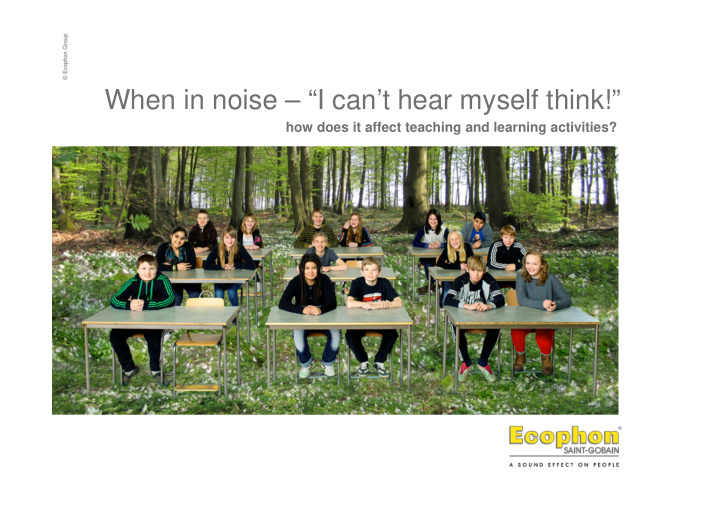



When in noise – “I can’t hear myself think!” how does it affect teaching and learning activities?
It is no longer like it was in my day!
More engagement is needed!
#IEQ Indoor Environmental Quality
Noise is now recognised as second most damaging to our health after air pollution
Drawing in a quiet environment
Same drawing in a noisy environment
Same child / drawing different sound levels
Acoustics in and beyond the classroom Create the natural outdoors - outdoors vs indoors
Our resources - human capital in EDUnet Design and acoustics Architecture and acoustics Acoustics and surveying Expertise Teaching in NET and technical Pedagogics and networking Pedagogics and teaching Acoustics and measurements
��� ��������� ��� ��� ��� ��������� ��������� ��������� �������� �������� �������� �������� �������� �������� �������� �������� ������ ������ ������ ������ ������� ������� ������� ������� ����������� ����������� ����������� ����������� �������������������� �������������������� �������������������� �������������������� !����������������� !����������������� !����������������� !����������������� ������������������� ������������������� ������������������� ������������������� ������������� ������������� ������������� ������������� ������������������� ������������������� ������������������� ������������������� �������������������"� �������������������"� �������������������"� �������������������"� �������������� ���� �������������� ���� �������������� ���� �������������� ���� ����������������� ����������������� ����������������� ����������������� #���������������� #���������������� #���������������� #���������������� ��������������������� ��������������������� ��������������������� ��������������������� ������������������"� ������������������"� ������������������"� ������������������"� ������������������� ������������������� ������������������� ������������������� ���������������� ���������������� ���������������� ���������������� ������������������� ������������������� ������������������� ������������������� �������������������" �������������������" �������������������" �������������������" ������� ������� ������� �������
Work Load Stress Working SPL and average Heart Rate 5min of the teacher 90 110 80 100 Heart rate [beats/min] SPL L Aeq [dBA] 70 90 60 80 Work. SPL, L Aeq 50 70 Heart freq., b/m 40 60 10:10 10:30 10:50 7:50 8:10 8:30 8:50 9:10 9:30 9:50 11:10
Classroom noise and concentration Increase of Basic SPL (L A95 ) before and after refurbishment 70 65 L A95 before ref. 60 L A95 after ref. 55 Basic SPL LA95 [dBA] 50 45 40 35 30 1 2 3 4 5 Lessons Data: Lab School, all lessons
Teaching styles and sound level differences Working Sound Pressure levels (L Aeq,5min ) before and after refurbishment 70 Work. SPL L Aeq,5min [dBA] 60 13 dB !!! 50 L Aeq before ref. L Aeq after ref. 40 30 Traditional Teaching Group work Data: Lab School, all lessons
Essex Study- Optimised classroom acoustics for all Study financed by Essex County Council, NDCS, FPS and the ANC Carried out by Hear2Learn and AJA Ltd Is there a benefit designing for the Inclusion of Hearing Impaired students - for all students and teachers? (2007- 2012) UK
Essex Study - 4 classrooms – 3 acoustic criteria 1.Untreated ”control” room 2.BB93 Min (Tmf) 3.BB93 Hi (Tmf) 4.BATOD (125-4000Hz)
Eliminating the perceived negatives
Sound levels (SNR) – ”Reverse Lombard” dB(A) Measured over 120 hours of lessons 8dB(A) 18dB(A) Untreated
Activity Based Acoustic Design approach
Need for balancing room acoustic qualities • Sound • Speech Clarity • Reverberance • Reverberance in low frequencies 125 Hz Sound Strength Speech Clarity Low frequencies Reverberation Time
Acoustic conditions for Speech, Listening & Learning Room acoustics Speakers voice Listeners ears • Hear the speech clearly • Understand what is said • Remember what was said • Capacity to think
Typical persons hearing threshold
1. Impaired hearing
Speech (im)balance - Information and Energy I E N F N O R E M A R T I G O Y N ENERGY INFORMATION Consonants Vowels
2. Promoting positive sounds - Reducing unwanted reflected sounds
Summary for speech and listener comfort Traditional teaching and group work Speaker Listener comfort comfort Acoustic Sky Acoustic Forest Reflector
Benefits of combined acoustic systems 1. Lower sound levels 2. Balance speech & hearing frequencies 3. Increase the speech intelligibility 4. Increase speaker comfort
Flexible classroom solutions - beyond min standards Working environment – Teachers` speech comfort Learning environment – Students` listening comfort
Other spaces, beyond the traditional classroom
Educational Environments Research - Innovative Learning Environments and Teacher Change This slide is used for start page and chaptering. Insert your image here (The image should cover the whole grey square by doing that you automatically follow the new graphic manual)
ILETC – background and aims • It is becoming clear that new learning environments require new teaching methods , and apart from a small number of examples, teaching practices in ILEs remain the same as in traditional classrooms. • This project aims to demonstrate how maximising the use of ILEs facilitates improved teaching practices and learning outcomes . It will collect data on how teachers enable learning most effectively in ILEs and identify causal evidence concerning the relationship between quality teaching and effective use of ILEs. This project will bridge the gap between the unrealised educational potential of innovative learning environment design and how they are currently used
ILETC – further aims • Develop mechanisms to identify ”teacher mindset” characteristics . • Develop strategies to assist teachers to maximise benefits available by the spaces in which they teach . • Conduct research on the effect this increased knowledge has on the quality of teaching, student’s deep learning and learning outcomes. Can altering teacher mind frames unlock the potential of innovative learning environments Collaborating on effective use of these learning spaces Acoustics is included, 1st time in a large pedagogic study
Recommend
More recommend